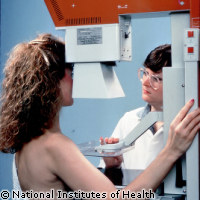Campaigners urge politicians to act on chemicals-breast cancer link
Health campaigners are urging politicians to act on the growing body of scientific evidence that links exposure to certain chemicals to spiralling rates of breast cancer. Scientists have known for decades that a woman's risk of developing breast cancer is influenced both by the levels of oestrogen produced by her own body and her use of drugs containing man-made oestrogens, such as hormone replacement therapy (HRT). Now a new report, 'Breast cancer and exposure to hormonally active chemicals', highlights the role of manmade chemicals which act like hormones in the development of breast cancer. The report, which was commissioned by the Health and Environment Alliance (HEAL) and CHEM Trust, was presented to Members of the European Parliament in Brussels on 2 April. 'Good laboratory and epidemiological evidence exists suggesting that man-made chemicals which mimic oestrogen contribute to breast cancer,' stated the report's author, Professor Andreas Kortenkamp of the University of London's School of Pharmacy. 'We will not be able to reduce the risk of breast cancer without addressing preventable causes, particularly exposure to chemicals.' Cases of breast cancer are on the rise across Europe, and over a million cases are diagnosed worldwide every year. 'Although late age at first child birth and genetics are shown to contribute to the increase in breast cancer, the sheer number of newly diagnosed cases cannot solely be explained by these factors,' the report reads. 'Evidence is emerging that environmental influences, including chemical exposure, also play a role.' At the launch of the report, Professor Kortenkamp presented evidence showing that while low levels of individual chemicals have no discernible impact on breast cancer, when mixtures of chemicals are considered together, they have a clear impact, even when the level of each individual chemical is very low. Professor Kortenkamp also highlighted the importance of exposure levels at different times in a woman's life; women are particularly vulnerable to elevated oestrogen levels in the womb, when the breast tissue is laid down, and at puberty, when the breasts' ductal system grows. For example, research shows that women who were exposed to the pesticide DDT during puberty are more likely to develop breast cancer than women who were exposed to it later in life, when their breast tissue was less vulnerable. Meanwhile another study focussed on women whose mothers took the drug DES (diethylstilboestrol) to avoid miscarriages, and so were exposed to synthetic oestrogens in the womb. The results revealed that these women face a doubled risk of developing breast cancer. The list of chemicals which act like hormones, and the products containing them, is long. Some of these chemicals, including DDT and some other pesticides, are already banned. However, there are many more, including bisphenol A (BPA), which is found in plastic food storage containers; parabens, which are used in cosmetics; UV-filters from sunscreens and alkylphenols, which are found in plastics, paints, inks and detergents. Scientists and health campaigners argue that as these chemicals are found in such a wide range of products, it is impossible for women to avoid exposure to them. The time is therefore ripe for regulators to take action to remove these chemicals from the environment, they say. As Professor Kortenkamp pointed out, the European Union has funded a lot of excellent research on this subject. However, 'this is not entirely matched by an equally well founded and well thought out regulatory approach to complement this, to act on the basis of scientific evidence,' he told CORDIS News. Meanwhile more research is needed. 'We need to do more epidemiological studies to find out why women get breast cancer - how do they differ from the ones who don't get breast cancer,' said Dr Annie Sasco, Team Leader for Epidemiology for Cancer Prevention at the French National Institute for Health and Medical Research (INSERM). Doing these studies will require the use of biological markers to determine which products people have been exposed to. Toxicological studies and experimental studies in animals are also needed, Dr Sasco added. 'The efforts to screen for oestrogen-like chemicals need to be redoubled,' said Professor Kortenkamp. 'We are far from having a complete picture about this.'



